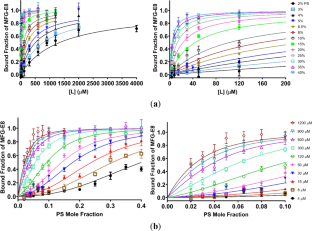MFG-E8: a model of multiple binding modes associated with ps-binding proteins
Abstract
Membrane-binding proteins often associate with lipid membranes through a singular binding interface which is generally modeled as a two-state system: bound or unbound. However, even a single interface can engage with more than one mode of binding since a variety of interactions can contribute to the binding event. Unfortunately, the ability to clearly delineate the different binding modes of a singular binding interface has been elusive with existing models. Here, we present a study on milk fat globule EGF factor 8 (MFG-E8), which belongs to a class of proteins that identifies and binds phosphatidylserine (PS). These proteins detect membrane dysregulation implicated in exposed PS in apoptosis and malignant cells. In order to elucidate the factors affecting the binding of MFG-E8, we used a model system consisting of a series of lipid vesicles with varying PS mole fraction to identify the sensitivity of MFG-E8’s binding affinity to changes in electrostatics using a tryptophan fluorescence spectral shift assay. Using a newly developed model, we experimentally identified three binding modes, each associated with a different number of PS lipids, with its cooperativity for binding being enhanced by the availability of negatively charged lipids. X-ray reflectivity experiments additionally suggest that MFG-E8’s binding modes are influenced by membrane packing. The protocols established for elucidating MFG-E8’s interaction with lipid membranes under different membrane conditions can be applied to the study of other membrane-binding proteins that target specific membrane attributes, such as fluidity and electrostatics, and help elucidate these membrane targeting mechanisms and their subsequent binding events.
Graphical abstract


 求助内容:
求助内容: 应助结果提醒方式:
应助结果提醒方式:


